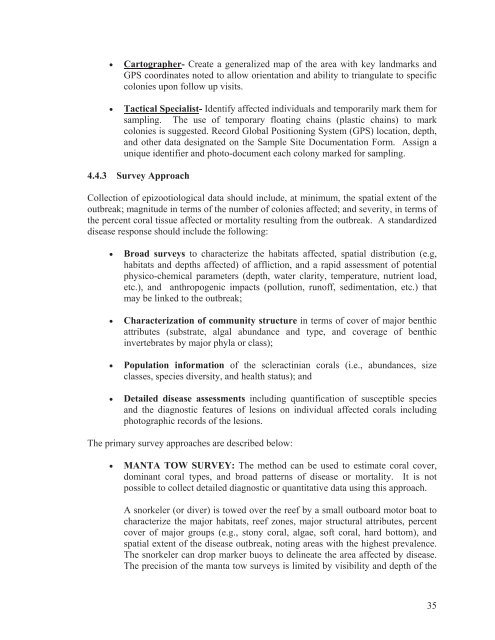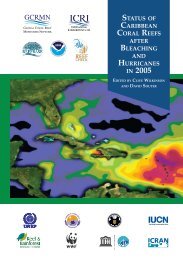Field Manual for the Investigation of Coral Disease Outbreaks
Field Manual for the Investigation of Coral Disease Outbreaks
Field Manual for the Investigation of Coral Disease Outbreaks
You also want an ePaper? Increase the reach of your titles
YUMPU automatically turns print PDFs into web optimized ePapers that Google loves.
Cartographer- Create a generalized map <strong>of</strong> <strong>the</strong> area with key landmarks andGPS coordinates noted to allow orientation and ability to triangulate to specificcolonies upon follow up visits.Tactical Specialist- Identify affected individuals and temporarily mark <strong>the</strong>m <strong>for</strong>sampling. The use <strong>of</strong> temporary floating chains (plastic chains) to markcolonies is suggested. Record Global Positioning System (GPS) location, depth,and o<strong>the</strong>r data designated on <strong>the</strong> Sample Site Documentation Form. Assign aunique identifier and photo-document each colony marked <strong>for</strong> sampling.4.4.3 Survey ApproachCollection <strong>of</strong> epizootiological data should include, at minimum, <strong>the</strong> spatial extent <strong>of</strong> <strong>the</strong>outbreak; magnitude in terms <strong>of</strong> <strong>the</strong> number <strong>of</strong> colonies affected; and severity, in terms <strong>of</strong><strong>the</strong> percent coral tissue affected or mortality resulting from <strong>the</strong> outbreak. A standardizeddisease response should include <strong>the</strong> following:Broad surveys to characterize <strong>the</strong> habitats affected, spatial distribution (e.g,habitats and depths affected) <strong>of</strong> affliction, and a rapid assessment <strong>of</strong> potentialphysico-chemical parameters (depth, water clarity, temperature, nutrient load,etc.), and anthropogenic impacts (pollution, run<strong>of</strong>f, sedimentation, etc.) thatmay be linked to <strong>the</strong> outbreak;Characterization <strong>of</strong> community structure in terms <strong>of</strong> cover <strong>of</strong> major benthicattributes (substrate, algal abundance and type, and coverage <strong>of</strong> benthicinvertebrates by major phyla or class);Population in<strong>for</strong>mation <strong>of</strong> <strong>the</strong> scleractinian corals (i.e., abundances, sizeclasses, species diversity, and health status); andDetailed disease assessments including quantification <strong>of</strong> susceptible speciesand <strong>the</strong> diagnostic features <strong>of</strong> lesions on individual affected corals includingphotographic records <strong>of</strong> <strong>the</strong> lesions.The primary survey approaches are described below:MANTA TOW SURVEY: The method can be used to estimate coral cover,dominant coral types, and broad patterns <strong>of</strong> disease or mortality. It is notpossible to collect detailed diagnostic or quantitative data using this approach.A snorkeler (or diver) is towed over <strong>the</strong> reef by a small outboard motor boat tocharacterize <strong>the</strong> major habitats, reef zones, major structural attributes, percentcover <strong>of</strong> major groups (e.g., stony coral, algae, s<strong>of</strong>t coral, hard bottom), andspatial extent <strong>of</strong> <strong>the</strong> disease outbreak, noting areas with <strong>the</strong> highest prevalence.The snorkeler can drop marker buoys to delineate <strong>the</strong> area affected by disease.The precision <strong>of</strong> <strong>the</strong> manta tow surveys is limited by visibility and depth <strong>of</strong> <strong>the</strong>35
















